Navratri or Shardiya Navratri is celebrated greatly throughout North and East India. Navratri is a symbolic celebration of the nine nights of the battle between good and evil, with good triumphing on the tenth day. During this time, Mother Durga is worshipped as the Goddess of power, energy, and wisdom.
Timing and Tithi
Navratri 2024 starts on October 3, Thursday and will end with the Vijaya Dasami celebration on Oct 12, Saturday.
Ashwina Navratri on Thursday, October 3, 2024
Pratipada Tithi start – October 02 | 2:48 PM in (United States)
Pratipada Tithi ends –October 03 | 5:28 PM in (United States)
When is the Navratri Festival 2024?
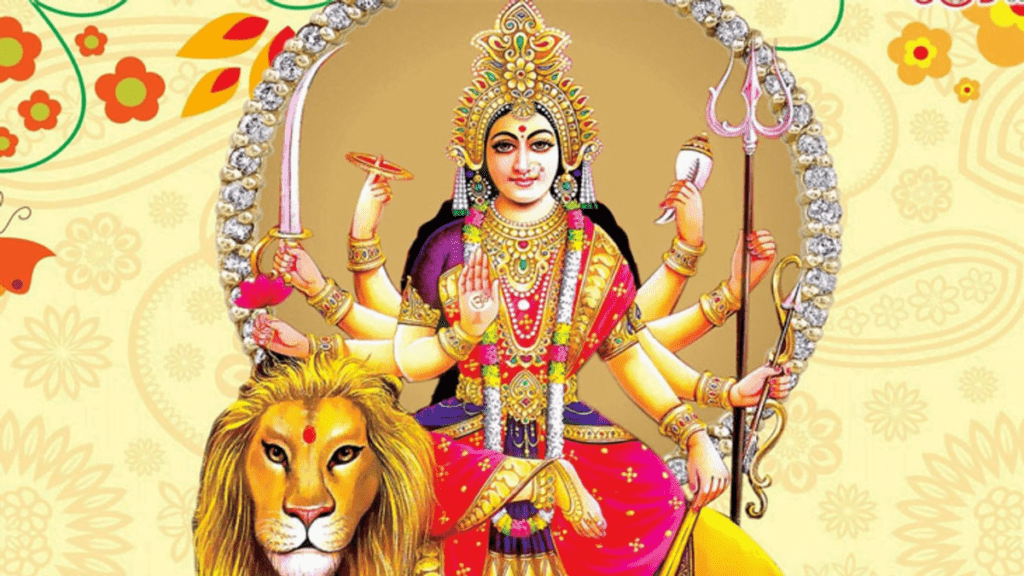
Navratri is usually celebrated twice a year. Once in spring (Chaitra Navratri) and once in autumn (Sharad Navratri). Both times testify to planetary changes according to the lunar calendar.
Sharad Navratri or Maha Navratri is commonly celebrated during the Indian month of Ashvina, which begins with the lunar week. According to the British calendar, it usually falls in September and sometimes in October.
This festival is celebrated over nine nights; devotees pray, participate in Dandiya Raas and Garbha, and offer Prasad to please Goddess Durga.
Durga Puja is celebrated from the 6th day of Navaratri. This lasts for four days and ends in Vijayadashmi.
Navratri Essentials Products from Divine Sansar
Spiritual Meaning of Navratri
According to mythology, there are various stories behind the founding of Navratri.
The demon king Mahishashur had started a war against the heavenly gods. To combat him, all the gods, including the trinity of Shiva, Brahma, and Vishnu, combined in divine power to produce the Mother of Power and ‘Shakti’. Thus Goddess Durga was created, and with her strength and wisdom, she killed Mahishashur after her nine nights of fierce battle with him. Therefore, the tenth day of victory is celebrated as Vijaya Dashami, the day of victory of good over evil.
Lord Rama was about to commence the war with Ravana to rescue Sita from being held captive by Lanka. Before the battle began, Rama worshipped Goddess Durga and sought her blessings. The puja required 108 lotus flowers. Just as Rama was about to remove one of his eyes, Goddess Durga appeared and blessed him with her sacred ‘Shakti’ to complete the count.
Uma, daughter of the Himalayan king Daksh, is said to return home for ten days during Navratri. She married Uma to Lord Shiva, and this festival celebrates her return to Earth.
Navratri: The Nine Incarnations of Goddess Durga
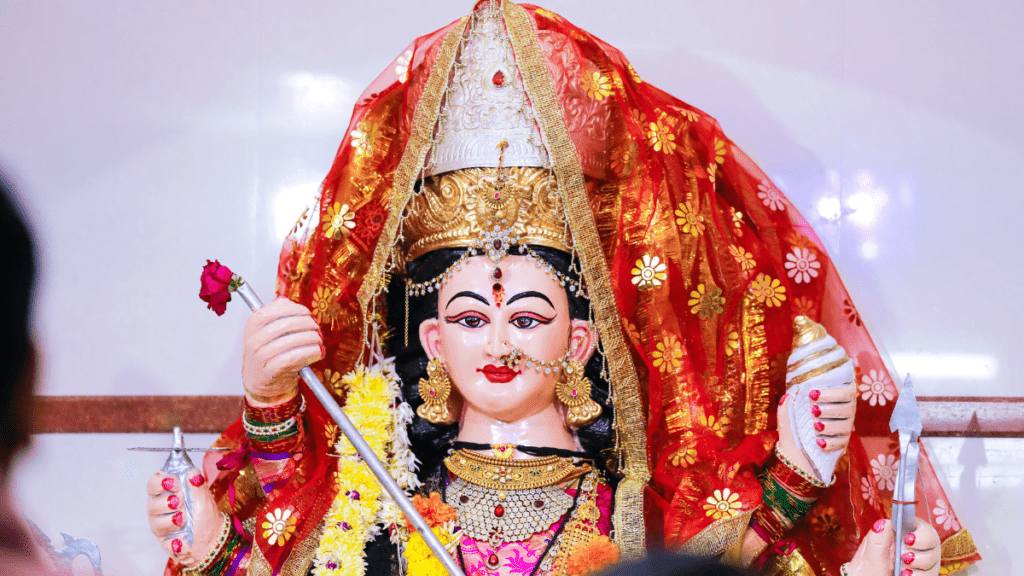
For nine days, people observe the festival with utmost devotion and prayer. Every day is dedicated to the avatar of Durga Maa. Based on this, followers should wear the correct colours every day.
Day 1: Shairaputri/Pratipada
On the first day, Devi Shailaputri is worshipped. In this form, Devi Parvati is revered as the daughter of Himalaya Raja. Shaila means extraordinary or rising to great heights. The divine consciousness represented by Devi always surges from the peak. On this first day of Navratri, we propitiate Devi Shailaputri so that we may also attain the highest state of consciousness.
Day 2: Brahmacharini/Dwitiya
On the second day, Devi Brahmacharini is propitiated. Devi Brahmacharini is the form of Devi Parvati in which she undertook severe penance to have Lord Shiva as Her consort. Brahma means divine consciousness and achar refers to behaviour. Brahmacharya is the behaviour or an act that is established in divine consciousness. This day is especially sacred to meditate and explore our inner divinity.
Day 3: Chandraganta/Tritiya
On the third day, Devi Chandraghata is the presiding Devi. Chandraghata is the special form that Devi Parvati assumed at the time of Her marriage with Lord Shiva. Chandra refers to the moon. The moon represents our mind. The mind is restless and keeps moving from one thought to another. Ghanta is a bell that produces only one kind of sound always. The significance is that when our mind is established at one point, i.e Divine, then our prana (subtle life force energy) gets consolidated leading to harmony and peace. This day thus signifies withdrawing from all vagaries of the mind, with a single focus on Mother Divine.
Day 4: Kushmanda/Chaturthi
On the fourth day, Mother Divine is worshipped as Devi Kushmanda. Kushmanda means a pumpkin. Ku means little, ushma means energy and refers to an egg. This entire universe which arose from the cosmic egg (hiranyagarbha) is manifested from the infinitesimal energy of Devi. A pumpkin also represents prana as it has the unique property of absorbing and radiating prana. It is one of the most pranic vegetables. On this day, we worship Devi Kushmanda who showers us with Her divine energy.
Day 5: Skandamata/Panchami
Skandamata means Mother of Skanda. On the fifth day, the motherly aspect of Devi Parvati is worshipped. In this form, she is the mother of Lord Karthikeya. She represents motherly affection (vatsalya). Worshipping this form of Devi brings an abundance of wisdom, wealth, power, prosperity and liberation.
6th Day: Kachaini/Shashti
On the sixth day, Devi manifests as Katyayani. It is a form that Mother Divine assumed to annihilate the demonic forces in the universe. She was born from the anger of the gods. She is the one who slew Mahishasura. As per our scriptures, anger that supports dharma (righteousness) is acceptable. Devi Katyayani represents that divine principle and form of the Mother Divine who is behind natural calamities and disasters. She is the anger that arises in creation to restore balance. Devi Katyayani is invoked on the sixth day to put an end to all our inner foes that are an obstacle on the path of spiritual evolution.
7th Day: Kalaratri/Saptami
On the seventh day, we invoke Devi Kalaratri. Mother Nature has two extremes. One is terrifying and devastating. The other is beautiful and serene. Devi Kalaratri is a fierce form of Devi. Kalaratri represents the dark night. The night is also considered an aspect of Mother Divine as it is the night that brings solace, rest and comfort to our souls. It is only at night that we get a glimpse of infinity in the skies. Devi Kalaratri is that infinite dark energy that houses innumerable universes.
8th Day: Mahagauri/Ashtami
Devi Mahagauri is that which is beautiful, gives momentum and freedom in life. Mahagauri represents the beautiful and serene aspect of Nature. She is that energy that propels our lives and also liberates us. She is the Devi who is worshipped on the eighth day.
Day 9: Siddhi Datri/Navami
On the ninth day, we worship Devi Siddhidatri. Siddhi means perfection. Devi Siddhidatri brings perfection in life. She makes the impossible, possible. She takes us beyond the ever reasoning logical mind to explore the realm beyond time and space.
10th Day: Vijayadashmi (Dussehra)
After nine days of prayer, the tenth day is reserved for Vijayadashmi. On this day, a new life begins. This is also called Vidhyarambam and is an event where children are introduced to the world of education. Sindhoor Khela is a very crucial part of the Vijayadashmi ritual.
Navaratri Ritual
During the Nine Nights of rituals, Goddess Durga is worshipped during the first three days as ‘Shakti’, the Goddess of power. During the next three days, she is worshipped as Lakshmi, the Goddess of wealth, and Saraswati, the Goddess of wisdom and knowledge, on the final days.
During this time, devotees fast and generally avoid grains, onions, meat and alcohol from their diet. Special Navratri dishes are prepared in North India for such devotees who are fasting.

Navratri 2024: Colours of Navratri
| Day 1 | October 3, Thursday | Yellow | Wear Yellow Colour on Thursday and enjoy your Navratri day with a sense of unparalleled optimism and joy.This is a warm colour that keeps the person cheerful all day. |
| Day 2 | October 4,Friday | Green | Green colour symbolizes nature and evokes a sense of growth,fertility, peace and serenity. Wear green on Friday and let the goddess bestows you with tranquillity. Green also represents new beginnings in life. |
| Day 3 | October 5, Saturday | Grey | Grey colour represents balanced emotions and keeps the person down-to-earth. This colour is also appropriate for those who want to participate in Navratri celebrations and make a subtle style statement with this undertone colour shade. |
| Day 4 | October 6, Sunday | Orange | Worshipping Goddess Navdurga wearing orange colour on Sunday bestows the person with qualities such as warmth and exuberance. This colour is full of positive energy and keeps the person upbeat. |
| Day 5 | October 7, Monday | White | White colour is synonymous with purity and innocence. Wear white colour on Monday to become worthy of Goddess’ blessings and experience a feeling of inner peace and security. |
| Day 6 | October 8, Tuesday | Red | On Tuesday, wear red colour for your Navratri celebrations. Red symbolizes passion and love and is also the most preferred colour of chunri that is offered to Goddess. This colour fills the person with vigour and vitality. |
| Day 7 | October 9, Wednesday | Royal Blue | Wear Royal Blue colour on Wednesday and participate in Navratri celebrations with unmatched panache and elegance. Royal Blue is a vivid shade of colour Blue and represents richness and tranquillity. |
| Day 8 | October 10, Thursday | Pink | Wear Pink colour on this day of navratri celebrations. Pink symbolizes universal love, affection and harmony.It is an attractive colour,makes the person approachable and simultaneously adds oodles of charm to one’s personality. |
| Day 9 | October 11 Friday | Purple | Purple colour is associated with luxury ,grandeur and nobility. Worshipping Navdurga wearing Purple bestows devotees with opulence and richness. So, do not shy away and don’t a beautiful Purple outfit to receive the blessings of Goddess. |
Navratri Vrat Katha
Guru Brihaspati, with great reverence, addressed Lord Brahma, saying, “O Brahma, you are the most wise, the foremost among those who know all the scriptures and the four Vedas. O Lord, please listen to my humble words. Why is the Navratri fast and celebration observed during the Shukla Paksha (waxing phase) of the months of Chaitra, Ashwin, Magh, and Ashadha? What is the significance of this fast? How should it be performed, and who was the first to observe it? Please explain in detail.”
Hearing Brihaspati’s question, Lord Brahma began to speak, “O Brihaspati, your inquiry, made with the intention of benefiting all beings, is truly commendable. Those who meditate on the goddess Durga, the Supreme Mother, along with the Sun and Narayana, are truly blessed. This Navratri fast is capable of fulfilling all desires. By observing it, one who seeks a child may be blessed with one, those seeking wealth may gain riches, those yearning for knowledge may attain wisdom, and those desiring happiness may find joy. This fast can cure the sick, free the imprisoned, and dispel all misfortunes, bringing prosperity to one’s household. Even a barren woman may conceive a child by observing this fast. There is no desire that cannot be fulfilled by this fast, which removes all sins.”
“If someone cannot fast all day, they may eat once and listen to the story of Navratri with their family. O Brihaspati, I will now recount the sacred history of the one who first observed this great vow. Listen carefully.”
After hearing Brahma’s words, Brihaspati said, “O Lord Brahma, I am listening attentively to this tale of the vow that brings welfare to all beings. Please be gracious to me.”
Lord Brahma continued, “In a beautiful city called Peethat, there lived a Brahmin named Anath, who was devoted to Goddess Durga. He had a daughter named Sumati, who was as beautiful as the first creation of Brahma himself. Sumati grew up like the waxing moon, playing with her friends and becoming more radiant each day. Her father, who worshiped Durga daily, was always pleased to see her devotion. However, one day, Sumati, absorbed in play, missed the daily worship of the goddess. Her father, noticing this neglect, was angered and said, ‘O wicked daughter, you have not participated in the worship of the goddess today! Therefore, I will marry you off to a leper or a poor man!'”

“These harsh words greatly saddened Sumati, and she replied, ‘Father, I am your daughter and entirely under your command. You may marry me off as you wish. I have full faith that whatever is written in my destiny will come to pass. A person may dream of many things, but what is destined will surely happen. Our actions are within our control, but the results are governed by fate.'”
“Upon hearing his daughter’s fearless words, the Brahmin’s anger only increased, and he married her to a leper. As she left, he said, ‘Go, go, quickly! Let’s see what your fate brings you!'”
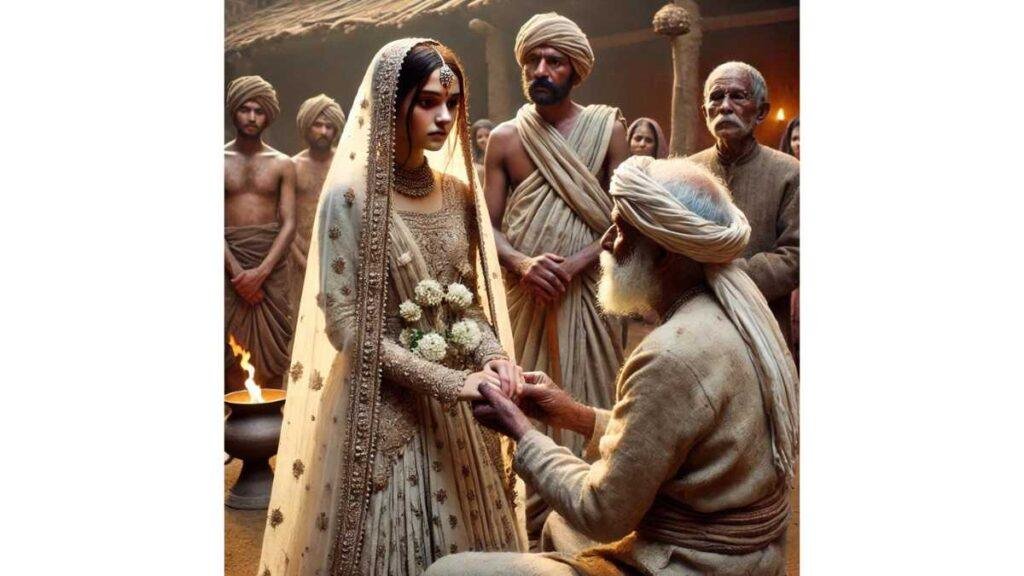
“Sumati, heartbroken by her father’s cruel words, accompanied her leprous husband to the forest. They spent a night in great misery in a desolate, grass-covered place. Seeing the young girl in such a state, the Goddess Durga, pleased by Sumati’s past virtues, appeared before her and said, ‘O Brahmin woman, I am pleased with you. Ask for any boon you desire, for I grant whatever one wishes when I am pleased.'”
“Sumati, astonished, asked, ‘Who are you, O Divine One, who has graced me with your presence? Please reveal yourself and bless me, your servant, with your grace.'”
“The goddess replied, ‘I am the primordial Shakti, the source of all power. I am Brahma, Saraswati, and all knowledge itself. When pleased, I remove the sorrows of all beings and grant them happiness. I am pleased with you because of your past life’s merits. Let me tell you about your previous birth. You were the wife of a Nishad (tribal hunter) and were very devoted to your husband. One day, both you and your husband were captured by soldiers for stealing and were imprisoned. During the Navratri days, you neither ate nor drank. Thus, you unintentionally observed the Navratri fast for nine days. I am pleased by the power of that fast and am here to grant you a boon. Ask whatever you wish.'”
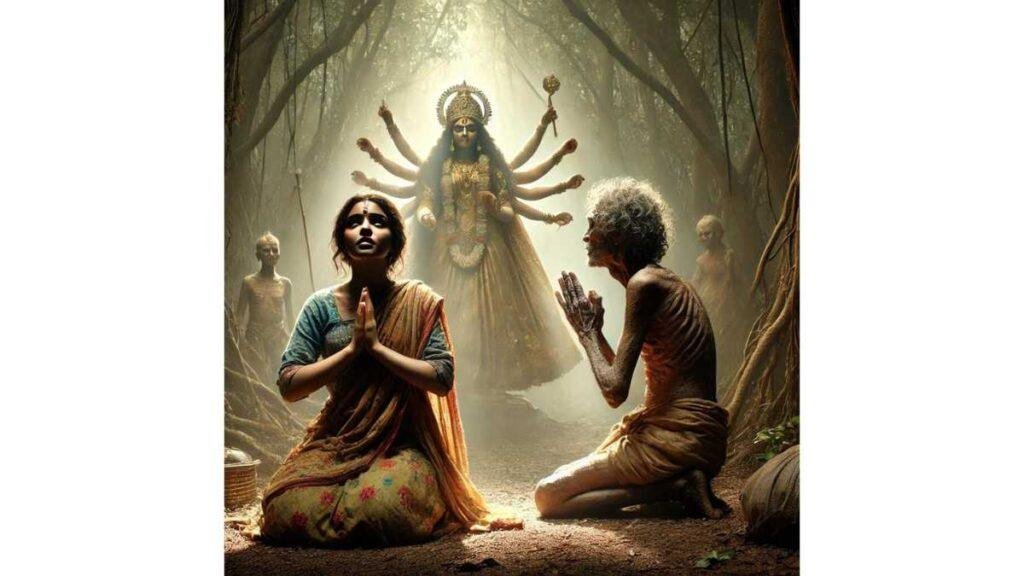
“Overwhelmed, Sumati said, ‘If you are truly pleased with me, O Durga, I ask that my husband be cured of his leprosy.'”
“The goddess replied, ‘Offer the merit of one day of that Navratri fast to cure your husband’s leprosy. By my grace, your husband will be cured and will have a body as radiant as gold.'”
“Brahma continued, ‘Hearing this, Sumati joyfully offered the merit, and instantly, her husband’s body became free of leprosy and shone with a brilliance that surpassed the moon. Seeing her husband transformed, Sumati praised the goddess, calling her the savior of the afflicted and the remover of all sorrow. She thanked the goddess for rescuing her from the sea of misfortune and prayed for continued protection.'”
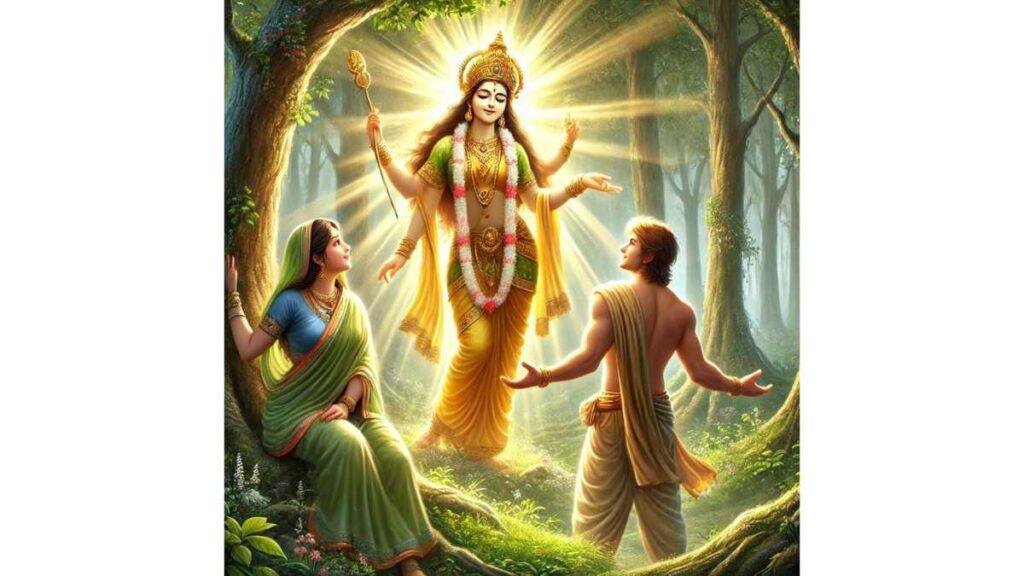
“Lord Brahma then narrated how the goddess further blessed Sumati with a wise, wealthy, and virtuous son named Udayal. Pleased by Sumati’s devotion, the goddess also revealed the method of performing the Navratri fast that pleases her and bestows the desired results. This fast, if performed correctly, can lead to the fulfillment of all desires and ultimately to moksha (liberation).”
“Thus, Brihaspati, the greatness of this rare and powerful vow has been revealed to you. Those who observe it with devotion will attain happiness in this world and the rarest liberation in the hereafter. Hearing this, Brihaspati was overwhelmed with joy and thanked Brahma, saying, ‘O Lord, you have bestowed immense grace upon me by revealing the nectar-like glory of this Navratri vow. Who else but you could share such divine knowledge?'”
“Brahma then praised Brihaspati for his noble inquiry, saying, ‘This goddess, the embodiment of all power, sustains the entire universe. Who can truly comprehend her greatness?'”

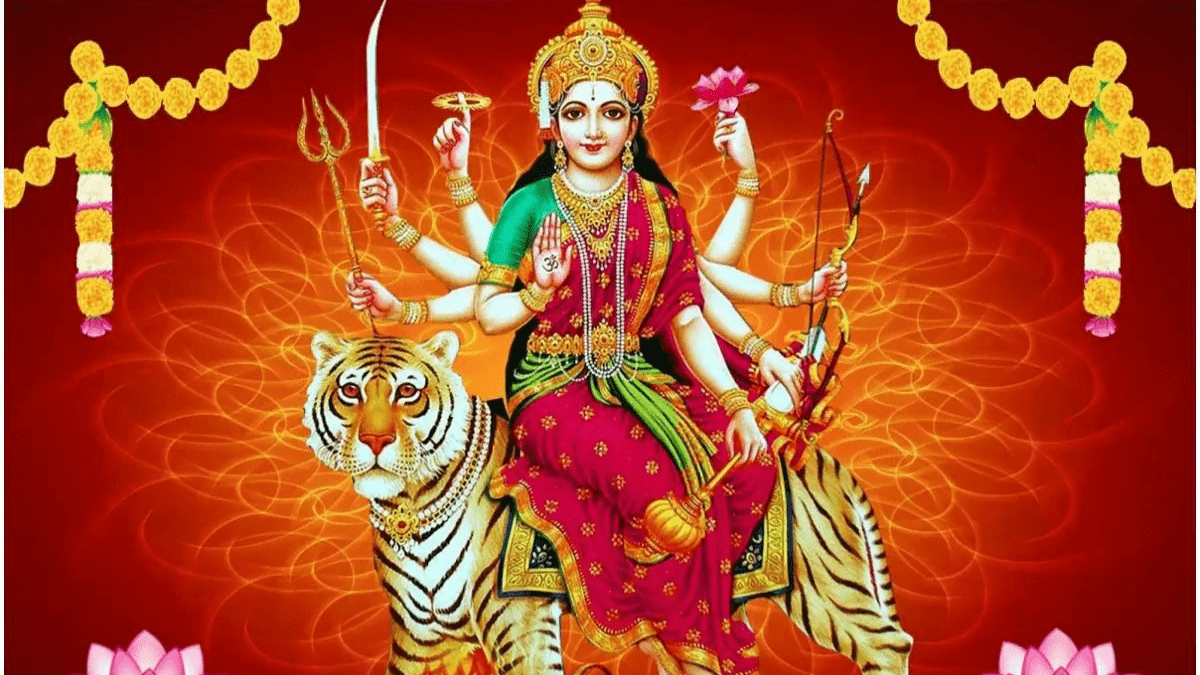


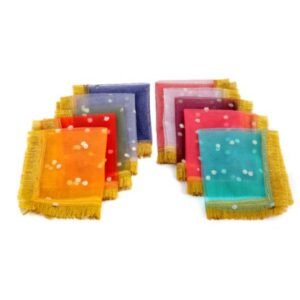




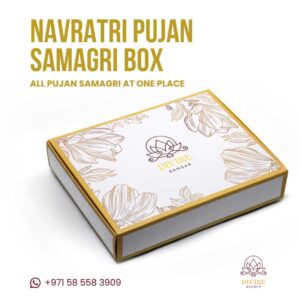
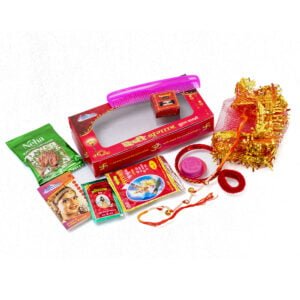


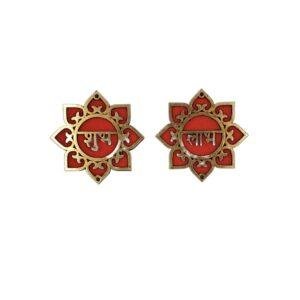



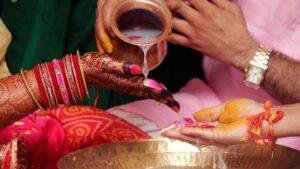

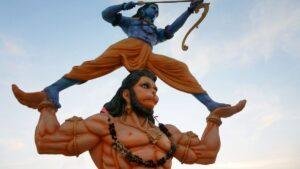





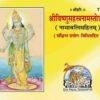





Add comment